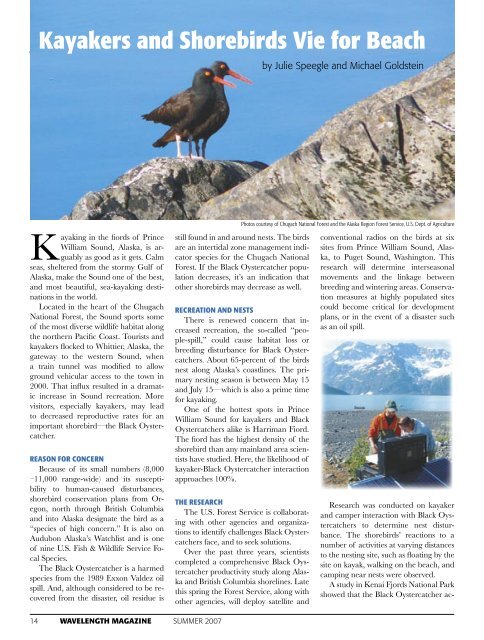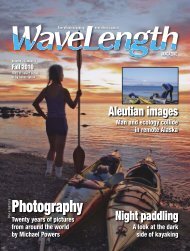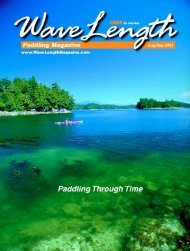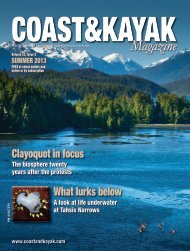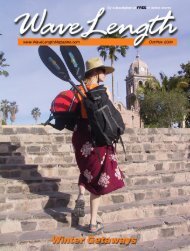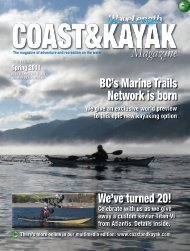download - Wavelength Paddling Magazine
download - Wavelength Paddling Magazine
download - Wavelength Paddling Magazine
You also want an ePaper? Increase the reach of your titles
YUMPU automatically turns print PDFs into web optimized ePapers that Google loves.
Kayakers and Shorebirds Vie for Beach<br />
Research was conducted on kayaker<br />
and camper interaction with Black Oystercatchers<br />
to determine nest disturbance.<br />
The shorebirds’ reactions to a<br />
number of activities at varying distances<br />
to the nesting site, such as floating by the<br />
site on kayak, walking on the beach, and<br />
camping near nests were observed.<br />
A study in Kenai Fjords National Park<br />
showed that the Black Oystercatcher acby<br />
Julie Speegle and Michael Goldstein<br />
Kayaking in the fiords of Prince<br />
William Sound, Alaska, is arguably<br />
as good as it gets. Calm<br />
seas, sheltered from the stormy Gulf of<br />
Alaska, make the Sound one of the best,<br />
and most beautiful, sea-kayaking destinations<br />
in the world.<br />
Located in the heart of the Chugach<br />
National Forest, the Sound sports some<br />
of the most diverse wildlife habitat along<br />
the northern Pacific Coast. Tourists and<br />
kayakers flocked to Whittier, Alaska, the<br />
gateway to the western Sound, when<br />
a train tunnel was modified to allow<br />
ground vehicular access to the town in<br />
2000. That influx resulted in a dramatic<br />
increase in Sound recreation. More<br />
visitors, especially kayakers, may lead<br />
to decreased reproductive rates for an<br />
important shorebird—the Black Oystercatcher.<br />
REASON FOR CONCERN<br />
Because of its small numbers (8,000<br />
–11,000 range-wide) and its susceptibility<br />
to human-caused disturbances,<br />
shorebird conservation plans from Oregon,<br />
north through British Columbia<br />
and into Alaska designate the bird as a<br />
“species of high concern.” It is also on<br />
Audubon Alaska’s Watchlist and is one<br />
of nine U.S. Fish & Wildlife Service Focal<br />
Species.<br />
The Black Oystercatcher is a harmed<br />
species from the 1989 Exxon Valdez oil<br />
spill. And, although considered to be recovered<br />
from the disaster, oil residue is<br />
Photos courtesy of Chugach National Forest and the Alaska Region Forest Service, U.S. Dept. of Agriculture<br />
still found in and around nests. The birds<br />
are an intertidal zone management indicator<br />
species for the Chugach National<br />
Forest. If the Black Oystercatcher population<br />
decreases, it’s an indication that<br />
other shorebirds may decrease as well.<br />
RECREATION AND NESTS<br />
There is renewed concern that increased<br />
recreation, the so-called “people-spill,”<br />
could cause habitat loss or<br />
breeding disturbance for Black Oystercatchers.<br />
About 65-percent of the birds<br />
nest along Alaska’s coastlines. The primary<br />
nesting season is between May 15<br />
and July 15—which is also a prime time<br />
for kayaking.<br />
One of the hottest spots in Prince<br />
William Sound for kayakers and Black<br />
Oystercatchers alike is Harriman Fiord.<br />
The fiord has the highest density of the<br />
shorebird than any mainland area scientists<br />
have studied. Here, the likelihood of<br />
kayaker-Black Oystercatcher interaction<br />
approaches 100%.<br />
THE RESEARCH<br />
The U.S. Forest Service is collaborating<br />
with other agencies and organizations<br />
to identify challenges Black Oystercatchers<br />
face, and to seek solutions.<br />
Over the past three years, scientists<br />
completed a comprehensive Black Oystercatcher<br />
productivity study along Alaska<br />
and British Columbia shorelines. Late<br />
this spring the Forest Service, along with<br />
other agencies, will deploy satellite and<br />
conventional radios on the birds at six<br />
sites from Prince William Sound, Alaska,<br />
to Puget Sound, Washington. This<br />
research will determine interseasonal<br />
movements and the linkage between<br />
breeding and wintering areas. Conservation<br />
measures at highly populated sites<br />
could become critical for development<br />
plans, or in the event of a disaster such<br />
as an oil spill.<br />
14 WAVELENGTH MAGAZINE SUMMER 2007


